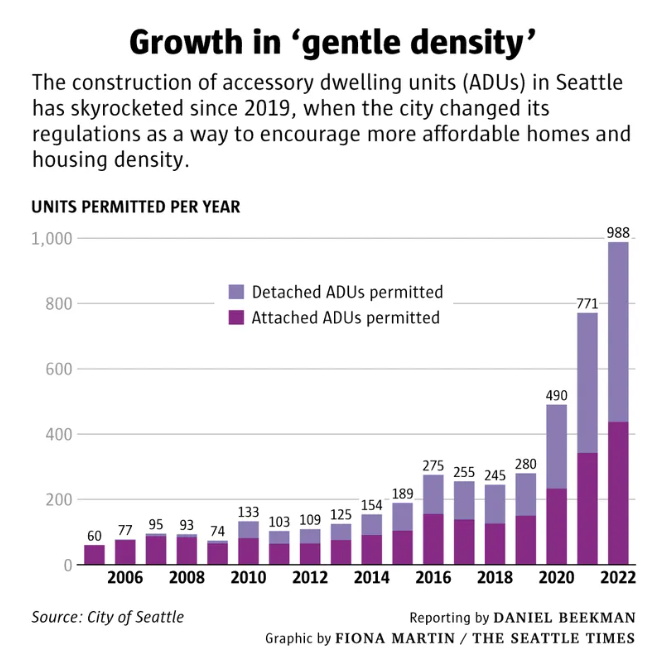In 2019, Seattle made it easier to build accessory dwelling units (ADUs). Among other things, they started allowing two ADUs per lot, they stopped requiring the owner to live on site, and they stopped requiring off-street parking. The result is that the city is now permitting close to 1,000 ADUs per year (2022 figure). And for the first time ever, this figure now exceeds the number of permits issued for single-family houses.

Part of what’s driving this adoption is that the City created 10 pre-approved plans that owners/builders can choose from. And since they were launched in September 2020, these plans have been permitted 130 times. (Los Angeles did something very similar with its “standard plan program.”)
In general though, Seattle’s policies seem more permissive than what we have here in Toronto. According to this recent “annual report”, it is estimated that about 12% of ADUs in Seattle are licensed as short-term rentals. About a third are also being permitted as condominiums. In Toronto, any sort of severance is heavily discouraged. The objective was and is to create new rental housing.
But for Seattle, this seems to be creating more affordable homes for sale. The median selling price for an ADU is apparently $732,000, compared to $1.2 million for a single-family house. This sounds kind of good.
Image: The Seattle Times

Interesting. So out of roughly (eyeballing the chart here) 1,200 detached ADUs in 2021-2022, only 130 (10-ish per cent) used the pre-approved plan route.
1- are the pre-approved plans not appealing?
2- is it just too hard to fit a standard design to Seattle topography?
3- is it a good use of staff time and gov’t resource to create pre-approved plans (maybe, perhaps they may have helped make detached ADUs more palatable to decisionmakers, even if they’re not used often)?
Second comment; I wonder if being able to sever the detached ADU and/or strata title it makes the whole business more appealing to lenders and thus makes more funding available to homeowners wanting to proceed (versus financing a new rental unit).
LikeLike
Good questions. I’m now curious how they are measuring the ROI on the 10 plans.
LikeLike
In Toronto we are feeling the limitations of democracy smacking into the horrors of demographics! We have an aging population trying to preserve the past (the true meaning of conservatism) and not giving a fig about a future they will not share. As long as they can vote, and they have nothing better to vote for, they will stay the course and politicians will blindly follow. We need a new better quality of politician; those who can contemplate “a richly imagined future” and can communicate to voters where the best interests of society lie. As long as we attract/allow goons who will unnecessarily rape the greenbelt just to line the pockets of a few buddies (election contributors) we are not likely to see much progress.
Maybe you, and some other like-minded people in the development industry should contemplate a movement that would position your part of the industry as strong willed societal leaders, not scavengers!
LikeLike
So, if an ADU sells for $732 000 US, it’ll have to rent for approximately $7320 US per month achieve break-even cash flow. Furthermore, most landlords prequalify potential renters by checking an applicant’s monthly income. To afford any rent, a person should earn 3x. That pencils out to about $22 000 per month in our Seattle example. A person earning $22 000 per month won’t be renting a garage suite…with an entrance facing a sketchy alley…with no parking for their 911 Targa.
LikeLike
How are you getting the US$7,320 per month number?
LikeLike
Simply by taking 1% of the purchase price. That’s my first test; it tells me if I stand a chance of breaking even each month. If I need to rent out a purchase for $3500 per month and I learn that the neighbourhood supports rents of $1700 per month, I know that I will struggle to find a renter at $3500. Alternately, I will have to make a much larger down payment to break even at the $1700 level.
Now, looking at the Seattle example in more detail, it’s possible to lower monthly expenses to a lower plateau. Starting with 10% down and a mortgage for the remainder at 6.64% (fixed term, 5 year duration, 25 years to pay out), I add all the other things that Canada Revenue Agency allows me to claim as expenses (property taxes, insurance, maintenance & management, advertising, utilities, office expenses, bank charges…), I come up with a slimmer figure of approximately $5600 US per month to service this new garage suite. That’s better than my first calculation but if readily available real estate data tells me that my chosen property is in a neighbourhood that supports $3000 monthly rents, I will have to get creative with my monthly cash flow calculation. If my goal is to break even every month at $5600, I increase the risk of a renter turning my beautiful new offering into a rooming house to meet rent. This happened to a friend in Florida; a three bedroom home was occupied by 10 people. It soon became uninhabitable.
Apologies for applying the Canadian tax code to an American example. Perhaps it’s possible to make the Seattle example work if you file your returns in the USA? Through my American friends, I know that the IRS allows for other deductions but I have not included them here because I do not have direct experience with the American tax code.
LikeLike
For a while now, we’ve been collaborating with landowners to construct ADU’s and DADU’s. Thanks to this ADU policy, these efforts have been instrumental in creating a more vibrant and livable city.
LikeLike
Pingback: Real estate investors are outbidding people who own strollers – BRANDON DONNELLY
We all need affordable living but I hope Seattle can continue to be a nice place to live for my family.
LikeLike